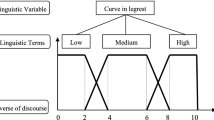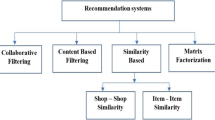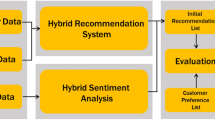Abstract
Many a times, customers regret their decision when they book a hotel room purely on the basis of price or the hotel images available online. The customers look for additional information to substantiate their decision and this has led to the popularity of the usage of online feedbacks provided by guests towards various aspects of the hotel services. This feedback more appropriately called the electronic word-of-mouth is provided either in terms of some rating or textual comments. The numerical ratings of various service aspects of the hotels posted by guests provide a comprehensive evaluation of their sentiments and assessments on a standardized scale. Studying these sentiments is necessary in order to understand the customer needs and identify the improvement areas for hoteliers. Customers consider various alternatives and gather relevant aspect information before booking a hotel room. This involves evaluating the hotel alternatives on the basis of more than one hotel characteristics. This demands application of multi criteria decision making approach for ranking of hotels. The paper proposes a hotel ranking model based on the aspect ratings accessed from Tripadvisor website. The aspects play the role of criteria consisting of service, cleanliness, value, sleep quality, room, and location. These ratings are classified into positive, neutral, and negative sentiments, which are transformed to Neutrosophic numbers and results in the formation of interval-valued Neutrosophic decision matrix. Also, since the aspect weights are completely unknown, a non-linear programming model called maximizing deviation method is employed. Lastly, the aspect weights and decision matrix are combined to perform the procedure required for applying technique for order preferences by similarity to ideal solution method for ranking five alternative hotels. Future studies may extend the present model for various product selection problems for which product feature ratings are available.




Similar content being viewed by others
References
Aggarwal AG, Aakash (2018) Multi-criteria-based prioritisation of B2C e-commerce website. Int J Soc Syst Sci 10(3):201–222
Alam MH, Ryu W-J, Lee S (2016) Joint multi-grain topic sentiment: modeling semantic aspects for online reviews. Inf Sci 339:206–223
Ali F (2016) Hotel website quality, perceived flow, customer satisfaction and purchase intention. J Hosp Tour Technol 7(2):213–228
Atanassov KT (1989) More on intuitionistic fuzzy sets. Fuzzy Sets Syst 33(1):37–45
Berezina K, Bilgihan A, Cobanoglu C, Okumus F (2016) Understanding satisfied and dissatisfied hotel customers: text mining of online hotel reviews. J Hosp Mark Manag 25(1):1–24
Fan Z-P, Xi Y, Liu Y (2018) Supporting consumer’s purchase decision: a method for ranking products based on online multi-attribute product ratings. Soft Comput 22(16):5247–5261
Feller W (2008) An introduction to probability theory and its applications, vol 2. Wiley, New York
Grail Q, Perez J (2018) Review QA: a relational aspect-based opinion reading dataset. arXiv:1810.12196
Guo C, Du Z, Kou X (2017) Mining online customer reviews for products aspect-based ranking. Paper presented at the international symposium on knowledge and systems sciences
Hargreaves CA (2015) Analysis of hotel guest satisfaction ratings and reviews: an application in Singapore. Am J Mark Res 1(4):208–214
Hu N, Bose I, Koh NS, Liu L (2012) Manipulation of online reviews: an analysis of ratings, readability, and sentiments. Decis Support Syst 52(3):674–684
Jain V, Sangaiah AK, Sakhuja S, Thoduka N, Aggarwal R (2018) Supplier selection using fuzzy AHP and TOPSIS: a case study in the Indian automotive industry. Neural Comput Appl 29(7):555–564
Kharal A (2014) A neutrosophic multi-criteria decision making method. New Math Nat Comput 10(02):143–162
Lau RY, Li C, Liao SS (2014) Social analytics: learning fuzzy product ontologies for aspect-oriented sentiment analysis. Decis Support Syst 65:80–94
Liu Y, Bi J-W, Fan Z-P (2017a) A method for ranking products through online reviews based on sentiment classification and interval-valued intuitionistic fuzzy TOPSIS. Int J Inf Technol Decis Mak 16(06):1497–1522
Liu Y, Bi J-W, Fan Z-P (2017b) Ranking products through online reviews: a method based on sentiment analysis technique and intuitionistic fuzzy set theory. Inf Fusion 36(July):149–161
Liu Y, Teichert T, Rossi M, Li H, Hu F (2017c) Big data for big insights: investigating language-specific drivers of hotel satisfaction with 412,784 user-generated reviews. Tour Manag 59(April):554–563
Mankad S, Han HS, Goh J, Gavirneni S (2016) Understanding online hotel reviews through automated text analysis. Serv Sci 8(2):124–138
Min H, Lim Y, Magnini VP (2015) Factors affecting customer satisfaction in responses to negative online hotel reviews: the impact of empathy, paraphrasing, and speed. Cornell Hosp Q 56(2):223–231
Najmi E, Hashmi K, Malik Z, Rezgui A, Khan HU (2015) CAPRA: a comprehensive approach to product ranking using customer reviews. Computing 97(8):843–867
Pandit S, Gupta S (2011) A comparative study on distance measuring approaches for clustering. Int J Res Comput Sci 2(1):29–31
Pang B, Lee L (2005) Seeing stars: exploiting class relationships for sentiment categorization with respect to rating scales. Paper presented at the proceedings of the 43rd annual meeting on association for computational linguistics
Peng Y, Kou G, Li J (2014) A fuzzy promethee approach for mining customer reviews in chinese. Arab J Sci Eng 39(6):5245–5252
Pham D-H, Le A-C (2018) Learning multiple layers of knowledge representation for aspect based sentiment analysis. Data Knowl Eng 114:26–39
Pramanik S, Dalapati S, Roy TK (2018) Neutrosophic multi-attribute group decision making strategy for logistics center location selection. Neutrosophic Oper Res 3:13–32
Şahin R, Liu P (2016) Maximizing deviation method for neutrosophic multiple attribute decision making with incomplete weight information. Neural Comput Appl 27(7):2017–2029
San-Martin S, Prodanova J, Jimenez N (2015) The impact of age in the generation of satisfaction and WOM in mobile shopping. J Retail Consum Serv 23:1–8
Sharma H, Aggarwal AG (2019) Finding determinants of e-commerce success: a PLS-SEM approach. J Adv Manag Res. https://doi.org/10.1108/JAMR-08-2018-0074
Smarandache F (ed) (2003) A unifying field in logics: neutrosophic logic. Neutrosophy, neutrosophic set, neutrosophic probability: neutrosophic logic: neutrosophy, neutrosophic set, neutrosophic probability. Infinite Study
Tandon A, Sharma H, Aggarwal AG (2019) Assessing travel websites based on service quality attributes under intuitionistic environment. Int J Knowl Based Organ 9(1):66–75
Titov I, McDonald R (2008) A joint model of text and aspect ratings for sentiment summarization. In: Proceedings of ACL-08: HLT. Association for Computational Linguistics, Columbus, pp 308–316
Valdivia A, Luzón MV, Herrera F (2017) Sentiment analysis in tripadvisor. IEEE Intell Syst 32(4):72–77
Wang H, Lu Y, Zhai C (2010) Latent aspect rating analysis on review text data: a rating regression approach. Paper presented at the proceedings of the 16th ACM SIGKDD international conference on knowledge discovery and data mining, Washington, DC, USA
Xiang Z, Schwartz Z, Gerdes JH Jr, Uysal M (2015a) What can big data and text analytics tell us about hotel guest experience and satisfaction? Int J Hosp Manag 44:120–130
Xiang Z, Schwartz Z, Uysal M (2015b) What types of hotels make their guests (un) happy? Text analytics of customer experiences in online reviews. In: Tussyadiah IA (ed) Information and communication technologies in tourism 2015. Springer, Berlin, pp 33–45
Xue W, Li T, Rishe N (2017) Aspect identification and ratings inference for hotel reviews. World Wide Web 20(1):23–37
Yang X, Yang G, Wu J (2016) Integrating rich and heterogeneous information to design a ranking system for multiple products. Decis Support Syst 84:117–133
Yang Y, Park S, Hu X (2018) Electronic word of mouth and hotel performance: a meta-analysis. Tour Manag 67(August):248–260
Ye Q, Law R, Gu B, Chen W (2011) The influence of user-generated content on traveler behavior: an empirical investigation on the effects of e-word-of-mouth to hotel online bookings. Comput Hum Behav 27(2):634–639
Yingming W (1997) Using the method of maximizing deviation to make decision for multiindices. J Syst Eng Electron 8(3):21–26
Yoon K, Hwang CL (1981) TOPSIS (technique for order preference by similarity to ideal solution)—a multiple attribute decision making, w: Multiple attribute decision making-methods and applications, a state-of-the-at survey. Springer, Berlin
Zadeh LA (1965) Fuzzy sets. Inf Control 8(3):338–353
Zhang K, Narayanan R, Choudhary AN (2010) Voice of the customers: mining online customer reviews for product feature-based ranking. WOSN 10:11
Zhang K, Cheng Y, Liao W, Choudhary A (2011) Mining millions of reviews: a technique to rank products based on importance of reviews. Paper presented at the Proceedings of the 13th international conference on electronic commerce, Liverpool, UK
Acknowledgements
This research work was supported by the Grants provided by Indian Council of Social Science Research, Delhi, India (File No.: 02/76/2017-18/RP/Major).
Author information
Authors and Affiliations
Corresponding author
Additional information
Publisher's Note
Springer Nature remains neutral with regard to jurisdictional claims in published maps and institutional affiliations.
Rights and permissions
About this article
Cite this article
Sharma, H., Tandon, A., Kapur, P.K. et al. Ranking hotels using aspect ratings based sentiment classification and interval-valued neutrosophic TOPSIS. Int J Syst Assur Eng Manag 10, 973–983 (2019). https://doi.org/10.1007/s13198-019-00827-4
Received:
Revised:
Published:
Issue Date:
DOI: https://doi.org/10.1007/s13198-019-00827-4




